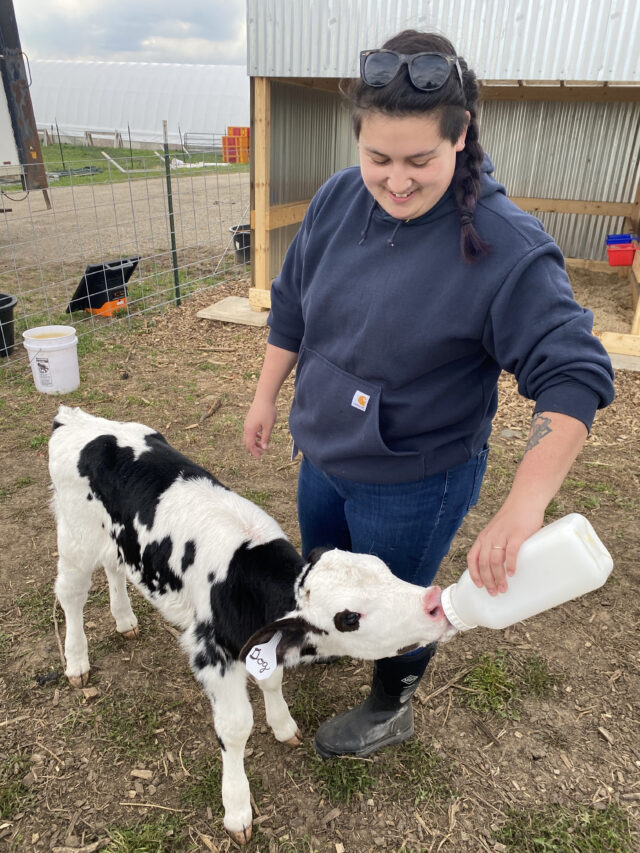My name is Tessa Parks and my husband Wyatt and I began our farm business, W.T. Farms, in 2018. After working on others’ farms and dabbling in farming on our own in Washington State for six years, we moved to Minnesota after I finished my undergrad studies at St. Olaf in order to find more affordable farmland.

We now raise Holstein steers that we purchase as day-old calves from a local dairy farmer. We practice rotational grazing with our animals on 20 acres of rented land at Sharing Our Roots, an educational farm and nonprofit in Northfield, MN. We ultimately market our steers as beef shares for our local community and the Minneapolis-St. Paul metro area.
While we’re grateful to operate as a part of the Sharing Our Roots landshare program, a major barrier in further developing our business has been finding more secure land closer to where we live. The land we rent is nearly half an hour from where we live, so we feel the strain as we raise animals 24/7, including bottle feeding calves, so far from home.
We envision a future where we can raise a diverse host of animals including pigs, chickens, and turkeys. Our current rental agreement does not allow hogs onsite; however, and because of the distance we live from the farm site, raising animals that require more frequent tending is difficult and unsustainable.
Though we live in a small town, surrounded by farmland, we are unable to find available land that will meet the needs of our growing farm anywhere nearby. Any space we are going to invest our time into needs to be one that can support regenerative practices, such as rotational grazing and bale grazing. Any parcels with water access and enough space are planted in conventional crops.
Land access isn’t our only barrier as young farmers. Our farm budget currently relies on Wyatt and I both working full-time jobs off the farm, which in turn limits the time and energy we have to invest in growing our operation. Many of our needs as a farm business rely on the approval of industry gatekeepers like USDA and Farm Credit, who have the power to deny us credit and access when purchasing feed, equipment, supplies, animals, and land. One of the only ways we have to mitigate their influence is by paying cash from our off-farm work for the equipment and supplies we need. We were very fortunate this season to receive financing for hay equipment; however, the loan would only cover 75% of the purchase value. Only because we had already invested heavily in the business from personal funds could we show sufficient equity to cover the remaining 25%. We worked with an agriculture specific lender that was able to underwrite the loan without us having cash, something other lenders generally will not do.

I am a Japanese-Filipino queer woman, and as part of a mixed-race couple I see the ease with which Wyatt navigates certain male-dominated spaces as a White man. When we’re together, it is obvious that he is assumed to be the farmer and I am just the “helpful wife.” When I go by myself to places like the farm supply store, I am regularly treated as if I am unable or unqualified to be buying farm supplies. On one occasion I was even cautioned that calves don’t make good pets simply because I was buying milk replacer. Obvious assumptions are made about my competency and legitimacy as a farmer based on my identity, and this stirs a hesitancy to talk to suppliers and lenders or approach larger financial institutions who otherwise provide services to local farms. In my experience, the funding and support gap between White male farmers and farmers of color is evident in nearly every aspect of the farming industry.
Wyatt and I are exploring options like working with Agrarian Commons, a nonprofit that supports beginning farmers with accessing land, as well as purchasing land outright as we continue to search for land to grow W.T. Farms. As we look for our permanent home, a primary goal of ours is to continue to be sustainable land stewards. Between our educational and professional experiences, we are both well aware of the environmental cost of poor farming practices. We believe it is in farmers’ best interest to protect the natural environment and practice conservation techniques as much as possible.